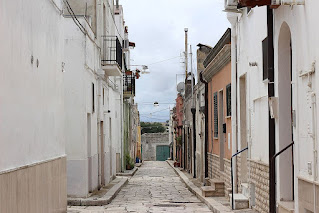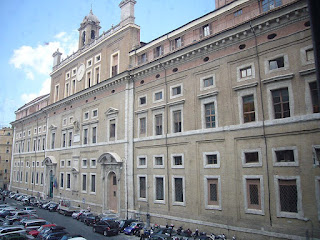Pontiff who banned nepotism in papal appointments
 |
| A divided papal conclave elected Pope Innocent XII as a compromise candidate |
Innocent XII, who was elected Pope in July 1691 and led the Catholic Church until his death in September 1700, issued the papal bull entitled Romanum decet pontificem within a year of taking office, abolishing the position of Cardinal-Nephew in the church hierarchy.
Cardinal-Nephew as an office in the church had been officially recognised since 1566 but the practice of appointing family members had been used by a succession of popes since the Middle Ages to help them consolidate family power and wealth in an era when papal authority extended well beyond the confines of the church.
The practice gave rise to the use of the term nepotism to describe the act of granting an advantage, privilege, or position to relatives or friends in any occupation or field. The word originates from cardinalis nepos, the Latin translation of cardinal nephew - cardinale nipote in Italian.
It was a practice Pignatelli was determined to stamp out, viewing it as an abuse of power, and he set out to build on the groundwork done by Pope Innocent XI between 1676 and 1689 but which his immediate predecessor, Pope Alexander VIII, had not advanced.
Pignatelli was born in Spinazzola, a town now in Puglia but then in the Kingdom of Naples, about 80km (50 miles) west of Bari. His aristocratic family included several Viceroys and ministers of the crown. He was educated at the Collegio Romano in Rome where he earned a doctorate in both canon and civil law.
 |
| Pope Innocent XII's tomb in Saint Peter's Basilica |
After he was ordained as a priest, he was made Titular Archbishop of Larissa. He subsequently served as the Apostolic Nuncio to Poland and later Austria. Pope Innocent XI appointed him as the Cardinal-Priest of San Pancrazio and then of Faenza. His final post before the papacy was Archbishop of Naples.
Pope Alexander VIII died in 1691, after which the conclave to select his successor was split between factions loyal to France, Spain and the broader Holy Roman Empire. After a five-month deadlock, Cardinal Pignatelli emerged as a compromise candidate and was crowned on July 15, when he was given possession of the Basilica of Saint John Lateran.
As well as outlawing the Cardinal-Nephew position, which meant that popes could not bestow estates, offices, or revenues on any relative, Innocent XII introduced other reforms.
These included economies in the way the church was run and improvements in the way the church administered justice. He also appointed Marcello Malpighi, a pioneer in the use of the microscope in medicine, as his personal physician and made him Professor of Medicine at the Sapienza University of Rome.
After a long period of ill health that caused him to miss a number of important engagements in 1700, Innocent XII died on September 27 of that year, to be succeeded by Pope Clement XI.
His tomb in Saint Peter's Basilica was sculpted by Filippo della Valle.
 |
| Via Acerenza is typical of the narrow, cobbled streets that fan out from Spinazzola's main street |
Formerly part of Basilicata, the border of which is less than 5km away, Spinazzola has been part of Puglia since 1811. It is a charming small town in the province of Barletta-Andria-Trani, with narrow cobblestone streets, traditional stone houses and a number of historic buildings, with Roman and Byzantine influences. The countryside around it is particularly picturesque. Pope Innocent XII’s family owned a castle in the town but it fell into disrepair and was demolished at the beginning of the 20th century. Some remains of a medieval city wall still exist, along with the 16th century mother church of San Pietro Apostolo and the first Templar hospital. Historic palaces include the Saracen Palace on Corso Vittorio Emanuele, one of the main streets through the town’s narrow historic centre. The centre of the town’s social life is Piazza Plebiscito, a square at the junction of Corso Vittorio Emanuele and Corso Umberto I.
Book your stay in Spinazzola with Booking.com
 |
| Rome's Collegio Romano, which Antonio Pignatelli attended before becoming Pope, was built in 1582 |
Rome’s Collegio Romano - the city’s Jesuit College - was established in 1551 by Ignatius Loyola, the founder of the Jesuit Order. A new building was erected for the College, under the patronage of Pope Gregory XIII, in 1582. The building can be found in the central Pigna district of the city in a square now known as Piazza del Collegio Romano. It is currently used partly by the Ministry of Heritage and Culture and partly by the Ennio Quirino Visconti high school. Pigna takes its name from an enormous Roman bronze statue in the shape of a pine cone, which once adorned an ancient Roman fountain. The sculpture was later moved to the Cortile del Belvedere at the Vatican Palace, where it stands alongside a pair of bronze Roman peacocks from Hadrian’s mausoleum. The area’s tourist attractions include the Pantheon, built in 118AD and considered to be Rome’s best preserved ancient building.
Accommodation in Rome from Booking.com
More reading:
Urban VIII, the pope whose extravagance led to disgrace
Why a 16th century Pope decreed that 10 days would not happen
The Pope who commissioned Michelangelo for the Sistine Chapel
Also on this day:
1853: The birth of actor and playwright Eduardo Scarpetta
1925: The birth of actor Corrado Gaipa
1955: The birth of footballer Bruno Conti
1960: The birth of rock musician Luciano Ligabue
1980: The birth of dancer Flavia Cacace
(Picture credits: tomb by Samuraijohnny; Via Acerenza by Forsehairagione; Collegio Romano by Lalupa; via Wikimedia Commons)
No comments:
Post a Comment